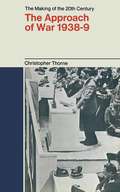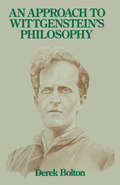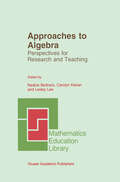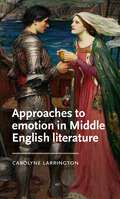- Table View
- List View
Apprehension and Argument: Ancient Theories of Starting Points for Knowledge (Studies in the History of Philosophy of Mind #3)
by Miira TuominenThis book offers the first synoptic study of how the primary elements in knowledge structures were analysed in antiquity from Plato to late ancient commentaries. It argues that, in the Platonic-Aristotelian tradition, the question of starting points was treated from two distinct points of view: as a question of how we acquire basic knowledge; and as a question of the premises we may immediately accept in the line of argumentation.
The Apprentice: Trump, Russia, And The Subversion Of American Democracy
by Greg MillerFrom Pulitzer Prize-winning Washington Post reporter Greg Miller comes an exclusive book uncovering the truth behind the Kremlin’s attempt to destroy Hillary Clinton and help Donald Trump win the presidency, Trump’s steadfast allegiance to Vladimir Putin and Robert Mueller’s ensuing investigation of the president and his entourage.
The Apprentice of Split Crow Lane: The Story of the Carr's Hill Murder
by Jane HoushamA Victorian Murder. A Victorian Madman. A Modern Judgement.Gateshead, April 1866The Apprentice of Split Crow Lane takes the forgotten case of a child murder in 1866 as a springboard to delve deeply into the pysche of the Victorians. What Jane Housham finds, in this exploration of guilt, sexual deviance and madness, is a diagnosis that is still ripe for the challenging and a sentence that provokes even our liberal modern judgement. Set around Gateshead, it is a revelatory social history of the North - an area growing in industry and swelling with immigration, where factory workers are tinged blue and yellow by chemicals, the first tabloids are printed, children are left alone by working parents and haystack fires sweep the county in rebellion against the introduction of the police force. Into this landscape, a five-year-old Irish girl named Sarah Melvin sets out over the fell to look for her father, and a troubled young man makes a frightening leap of logic to save his own skin.Told here for the first time, this is an extraordinary story of sexual deviance and murder. In lively, empathic prose, Jane Housham explores psychiatry, the justice system and the media in mid-Victorian England to reveal a surprisingly modern state of affairs.
The Apprentices
by Leon GarfieldLife in eighteenth-century London was hard and especially so for the city's apprentices. For seven long years they struggled for their livelihoods among the fetid houses and sinister quays of old London. But despite their hardships there was hope and even fun.This compelling story-cycle follows them round the year, through the dark, cold winter nights to midsummer in the city, The lamplighter, the pawnbroker, the midwife or the clockmaker, their stories interweave delightfully to paint a colourful picture of life in London 200 years ago.
Apprenticeship in Critical Ethnographic Practice (Lewis Henry Morgan Lecture Series #1993)
by Jean LaveIn this extended meditation, Jean Lave interweaves analysis of the process of apprenticeship among the Vai and Gola tailors of Liberia with reflections on the evolution of her research on those tailors in the late 1970s. In so doing, she provides both a detailed account of her apprenticeship in the art of sustained fieldwork and an insightful overview of thirty years of changes in the empirical and theoretical facets of ethnographic practice. Examining the issues she confronted in her own work, Lave shows how the critical questions raised by ethnographic research erode conventional assumptions, altering the direction of the work that follows. As ethnography takes on increasing significance to an ever widening field of thinkers on topics from education to ecology, this erudite but accessible book will be essential to anyone tackling the question of what it means to undertake critical and conceptually challenging fieldwork. Apprenticeship in Critical Ethnographic Practice explains how to seriously explore what it means to be human in a complex world—and why it is so important.
Apprenticeship in Critical Ethnographic Practice (Lewis Henry Morgan Lecture Series #1993)
by Jean LaveIn this extended meditation, Jean Lave interweaves analysis of the process of apprenticeship among the Vai and Gola tailors of Liberia with reflections on the evolution of her research on those tailors in the late 1970s. In so doing, she provides both a detailed account of her apprenticeship in the art of sustained fieldwork and an insightful overview of thirty years of changes in the empirical and theoretical facets of ethnographic practice. Examining the issues she confronted in her own work, Lave shows how the critical questions raised by ethnographic research erode conventional assumptions, altering the direction of the work that follows. As ethnography takes on increasing significance to an ever widening field of thinkers on topics from education to ecology, this erudite but accessible book will be essential to anyone tackling the question of what it means to undertake critical and conceptually challenging fieldwork. Apprenticeship in Critical Ethnographic Practice explains how to seriously explore what it means to be human in a complex world—and why it is so important.
Apprenticeship in Critical Ethnographic Practice (Lewis Henry Morgan Lecture Series #1993)
by Jean LaveIn this extended meditation, Jean Lave interweaves analysis of the process of apprenticeship among the Vai and Gola tailors of Liberia with reflections on the evolution of her research on those tailors in the late 1970s. In so doing, she provides both a detailed account of her apprenticeship in the art of sustained fieldwork and an insightful overview of thirty years of changes in the empirical and theoretical facets of ethnographic practice. Examining the issues she confronted in her own work, Lave shows how the critical questions raised by ethnographic research erode conventional assumptions, altering the direction of the work that follows. As ethnography takes on increasing significance to an ever widening field of thinkers on topics from education to ecology, this erudite but accessible book will be essential to anyone tackling the question of what it means to undertake critical and conceptually challenging fieldwork. Apprenticeship in Critical Ethnographic Practice explains how to seriously explore what it means to be human in a complex world—and why it is so important.
The Apprenticeship of a Mathematician
by Andre WeilFrom reviews: "Extremely readable... rare testimony of a period of the history of 20th century mathematics. Includes very interesting recollections on the author's participation in the formation of the Bourbaki Group, tells of his meetings and conversations with leading mathematicians, reflects his views on mathematics. The book describes an extraordinary career of an exceptional man and mathematicians. Strongly recommended to specialists as well as to the general public." --EMS Newsletter (1992)
Apprenticeship, Work, Society in Early Modern Venice
by Anna Bellavitis Valentina SapienzaApprenticeship in early modern Europe has been the subject of important research in the last decades, mostly by economic historians, but the majority of the research has dealt with cities or countries in Northern Europe. The organization, evolution and purpose of apprenticeship in Southern Europe are much less studied, especially for the early modern period. The research in this volume is based on a unique documentary source: more than 54,000 apprenticeship contracts registered from 1575 to 1772 by the ‘Old Justice’, a civil court of the Republic of Venice in charge of guilds and labour disputes. An archival source of such scale provides a unique opportunity to historians and this is the first time that primary research on apprenticeship is leveraging such a large amount of data in one of the main economic centres of early modern Europe. This book brings together multiple perspectives including social history, economic history and art history and is the outcome of an interdisciplinary collaboration between historians and computer scientists. Apprenticeship, Work, Society in Early Modern Venice will appeal to students and researchers alike interested in the nature of work and employment in Venice and Italy as well as society in Early Modern Europe more generally.
Apprenticeship, Work, Society in Early Modern Venice
by Anna Bellavitis Valentina SapienzaApprenticeship in early modern Europe has been the subject of important research in the last decades, mostly by economic historians, but the majority of the research has dealt with cities or countries in Northern Europe. The organization, evolution and purpose of apprenticeship in Southern Europe are much less studied, especially for the early modern period. The research in this volume is based on a unique documentary source: more than 54,000 apprenticeship contracts registered from 1575 to 1772 by the ‘Old Justice’, a civil court of the Republic of Venice in charge of guilds and labour disputes. An archival source of such scale provides a unique opportunity to historians and this is the first time that primary research on apprenticeship is leveraging such a large amount of data in one of the main economic centres of early modern Europe. This book brings together multiple perspectives including social history, economic history and art history and is the outcome of an interdisciplinary collaboration between historians and computer scientists. Apprenticeship, Work, Society in Early Modern Venice will appeal to students and researchers alike interested in the nature of work and employment in Venice and Italy as well as society in Early Modern Europe more generally.
Apprenticeships: The Bildungsroman from Goethe to Santayana
by T. JeffersNovels about growing up have long been loved by ordinary readers and analyzed, sometimes with more heat than light, by scholars. This book respects the interests of ordinary readers while clarifying and frequently resolving the moral, psychological, social, and occasionally religious coming-of-age dilemmas that scholars have wrestled with. Focusing on Goethe's Wilhelm Meister, Dickens's David Copperfield, James's What Maisie Knew, Forster's The Longest Journey, Lawrence's Sons and Lovers, and Santayana's The Last Puritan, Jeffers writes in a fresh, engaging style meant to give criticism a liveliness and even brilliance it has in recent decades often lacked.
APPROACH TO TEACH HIST OF ENG LANG C: Pedagogy in Practice
by Mary Hayes and Allison BurketteThe History of the English Language has been a standard university course offering for over 150 years. Yet relatively little has been written about teaching a course whose very title suggests its prodigious chronological, geographic, and disciplinary scope. In the nineteenth century, History of the English Language courses focused on canonical British literary works. Since these early curricula were formed, the English language has changed, and so have the courses. In the twenty-first century, instructors account for the growing prominence of World Englishes as well as the English language's transformative relationship with the internet and social media. Approaches to Teaching the History of the English Language addresses the challenges and circumstances that the course's instructors and students commonly face. The volume reads as a series of "master classes" taught by experienced instructors who explain the pedagogical problems that inspired resourceful teaching practices. Although its chapters are authored by seasoned teachers, many of whom are preeminent scholars in their individual fields, the book is designed for instructors at any career stage-beginners and veterans alike. The topics addressed in Approaches to Teaching the History of the English Language include: the unique pedagogical dynamic that transpires in language study; the course's origins and relevance to current university curricula; scholarly approaches that can offer an abiding focus in a semester-long course; advice about navigating the course's formidable chronological ambit; ways to account for the language's many varieties; and the course's substantial and pedagogical relationship to contemporary multimedia platforms. Each chapter balances theory and practice, explaining in detail activities, assignments, or discussion questions ready for immediate use by instructors.
Approaches to Algebra: Perspectives for Research and Teaching (Mathematics Education Library #18)
by N. Bednarz C. Kieran L. LeeIn Greek geometry, there is an arithmetic of magnitudes in which, in terms of numbers, only integers are involved. This theory of measure is limited to exact measure. Operations on magnitudes cannot be actually numerically calculated, except if those magnitudes are exactly measured by a certain unit. The theory of proportions does not have access to such operations. It cannot be seen as an "arithmetic" of ratios. Even if Euclidean geometry is done in a highly theoretical context, its axioms are essentially semantic. This is contrary to Mahoney's second characteristic. This cannot be said of the theory of proportions, which is less semantic. Only synthetic proofs are considered rigorous in Greek geometry. Arithmetic reasoning is also synthetic, going from the known to the unknown. Finally, analysis is an approach to geometrical problems that has some algebraic characteristics and involves a method for solving problems that is different from the arithmetical approach. 3. GEOMETRIC PROOFS OF ALGEBRAIC RULES Until the second half of the 19th century, Euclid's Elements was considered a model of a mathematical theory. This may be one reason why geometry was used by algebraists as a tool to demonstrate the accuracy of rules otherwise given as numerical algorithms. It may also be that geometry was one way to represent general reasoning without involving specific magnitudes. To go a bit deeper into this, here are three geometric proofs of algebraic rules, the frrst by Al-Khwarizmi, the other two by Cardano.
Approaches to American Cultural Studies
by Antje Dallmann Eva Boesenberg Martin KlepperApproaches to American Cultural Studies provides an accessible yet comprehensive overview of the diverse range of subjects encompassed within American Studies, familiarising students with the history and shape of American Studies as an academic subject as well as its key theories, methods, and concepts. Written and edited by an international team of authors based primarily in Europe, the book is divided into four thematically-organised sections. The first part delineates the evolution of American Studies over the course of the twentieth century, the second elaborates on how American Studies as a field is positioned within the wider humanities, and the third inspects and deconstructs popular tropes such as myths of the West, the self-made man, Manifest Destiny, and representations of the President of the United States. The fourth part introduces theories of society such as structuralism and deconstruction, queer and transgender theories, border and hemispheric studies, and critical race theory that are particularly influential within American Studies. This book is supplemented by a companion website offering further material for study (www.routledge.com/cw/dallmann). Specifically designed for use on courses across Europe, it is a clear and engaging introductory text for students of American culture.
Approaches to American Cultural Studies
by Antje Dallmann Eva Boesenberg Martin KlepperApproaches to American Cultural Studies provides an accessible yet comprehensive overview of the diverse range of subjects encompassed within American Studies, familiarising students with the history and shape of American Studies as an academic subject as well as its key theories, methods, and concepts. Written and edited by an international team of authors based primarily in Europe, the book is divided into four thematically-organised sections. The first part delineates the evolution of American Studies over the course of the twentieth century, the second elaborates on how American Studies as a field is positioned within the wider humanities, and the third inspects and deconstructs popular tropes such as myths of the West, the self-made man, Manifest Destiny, and representations of the President of the United States. The fourth part introduces theories of society such as structuralism and deconstruction, queer and transgender theories, border and hemispheric studies, and critical race theory that are particularly influential within American Studies. This book is supplemented by a companion website offering further material for study (www.routledge.com/cw/dallmann). Specifically designed for use on courses across Europe, it is a clear and engaging introductory text for students of American culture.
Approaches to Byzantine Architecture and its Decoration: Studies in Honor of Slobodan Curcic
by Mark J. Johnson Amy PapalexandrouThe fourteen essays in this collection demonstrate a wide variety of approaches to the study of Byzantine architecture and its decoration, a reflection of both newer trends and traditional scholarship in the field. The variety is also a reflection of Professor Curcic’s wide interests, which he shares with his students. These include the analysis of recent archaeological discoveries; recovery of lost monuments through archival research and onsite examination of material remains; reconsidering traditional typological approaches often ignored in current scholarship; fresh interpretations of architectural features and designs; contextualization of monuments within the landscape; tracing historiographic trends; and mining neglected written sources for motives of patronage. The papers also range broadly in terms of chronology and geography, from the Early Christian through the post-Byzantine period and from Italy to Armenia. Three papers examine Early Christian monuments, and of these two expand the inquiry into their architectural afterlives. Others discuss later monuments in Byzantine territory and monuments in territories related to Byzantium such as Serbia, Armenia, and Norman Italy. No Orthodox church being complete without interior decoration, two papers discuss issues connected to frescoes in late medieval Balkan churches. Finally, one study investigates the continued influence of Byzantine palace architecture long after the fall of Constantinople.
Approaches to Byzantine Architecture and its Decoration: Studies in Honor of Slobodan Curcic
by Mark J. Johnson Amy PapalexandrouThe fourteen essays in this collection demonstrate a wide variety of approaches to the study of Byzantine architecture and its decoration, a reflection of both newer trends and traditional scholarship in the field. The variety is also a reflection of Professor Curcic’s wide interests, which he shares with his students. These include the analysis of recent archaeological discoveries; recovery of lost monuments through archival research and onsite examination of material remains; reconsidering traditional typological approaches often ignored in current scholarship; fresh interpretations of architectural features and designs; contextualization of monuments within the landscape; tracing historiographic trends; and mining neglected written sources for motives of patronage. The papers also range broadly in terms of chronology and geography, from the Early Christian through the post-Byzantine period and from Italy to Armenia. Three papers examine Early Christian monuments, and of these two expand the inquiry into their architectural afterlives. Others discuss later monuments in Byzantine territory and monuments in territories related to Byzantium such as Serbia, Armenia, and Norman Italy. No Orthodox church being complete without interior decoration, two papers discuss issues connected to frescoes in late medieval Balkan churches. Finally, one study investigates the continued influence of Byzantine palace architecture long after the fall of Constantinople.
Approaches to emotion in Middle English literature (Manchester Medieval Literature and Culture)
by Carolyne LarringtonOver the last twenty-five years, the ‘history of emotion’ field has become one of the most dynamic and productive areas for humanities research. This designation, and the marked leadership of historians in the field, has had the unlooked-for consequence of sidelining literature — in particular secular literature — as evidence-source and object of emotion study. Secular literature, whether fable, novel, fantasy or romance, has been understood as prone to exaggeration, hyperbole, and thus as an unreliable indicator of the emotions of the past.The aim of this book is to decentre history of emotion research and asks new questions, ones that can be answered by literary scholars, using literary texts as sources: how do literary texts understand and depict emotion and, crucially, how do they generate emotion in their audiences — those who read them or hear them read or performed?
Approaches to emotion in Middle English literature (Manchester Medieval Literature and Culture)
by Carolyne LarringtonOver the last twenty-five years, the ‘history of emotion’ field has become one of the most dynamic and productive areas for humanities research. This designation, and the marked leadership of historians in the field, has had the unlooked-for consequence of sidelining literature — in particular secular literature — as evidence-source and object of emotion study. Secular literature, whether fable, novel, fantasy or romance, has been understood as prone to exaggeration, hyperbole, and thus as an unreliable indicator of the emotions of the past.The aim of this book is to decentre history of emotion research and asks new questions, ones that can be answered by literary scholars, using literary texts as sources: how do literary texts understand and depict emotion and, crucially, how do they generate emotion in their audiences — those who read them or hear them read or performed?
Approaches to Global History: To See the World Whole
by Felipe Fernández-ArmestoThis volume brings together 25 defining texts in global history. These pieces cover approaches to the subject from antiquity to the present century and, taken together, show the development of the discipline, providing a solid historiographical, theoretical and methodological overview that will be invaluable for students. The collection gives a unique sense of how, at different times, in different cultural circumstances, students of the past have approached the problems of encompassing the world in a single narrative or theory. This is a reader with an implicit story to unfold. Felipe Fernandez-Armesto tracks how a global understanding of history originated in prophetic writings, how the “Renaissance discovery of the world” multiplied the opportunities for historians to think about history globally, how scientific investigations of change came to exert influence and inspire new thinking among global historians, how “culture wars” ensued between advocates of scientistic and culturalist models and how changing contexts in the 20th century produced new thematic approaches to the world as a whole. Each part is introduced, setting it in context and explaining the impact of its subject matter on the discipline, as well as the relations between the texts and their place in the overall development of global history.
Approaches to Global History: To See the World Whole
This volume brings together 25 defining texts in global history. These pieces cover approaches to the subject from antiquity to the present century and, taken together, show the development of the discipline, providing a solid historiographical, theoretical and methodological overview that will be invaluable for students. The collection gives a unique sense of how, at different times, in different cultural circumstances, students of the past have approached the problems of encompassing the world in a single narrative or theory. This is a reader with an implicit story to unfold. Felipe Fernandez-Armesto tracks how a global understanding of history originated in prophetic writings, how the “Renaissance discovery of the world” multiplied the opportunities for historians to think about history globally, how scientific investigations of change came to exert influence and inspire new thinking among global historians, how “culture wars” ensued between advocates of scientistic and culturalist models and how changing contexts in the 20th century produced new thematic approaches to the world as a whole. Each part is introduced, setting it in context and explaining the impact of its subject matter on the discipline, as well as the relations between the texts and their place in the overall development of global history.
Approaches to History: A Symposium (Routledge Library Editions: Historiography)
by H. P. FinbergThe contributors to this volume, originally published in 1962, explain the raison d’être of their own specialism in history be it archaeology, political, local, economic or social history or historical geography.

















